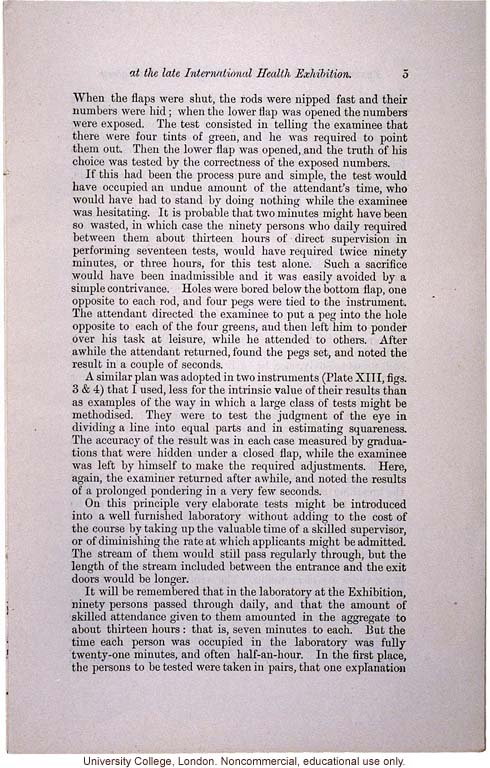at the late International Health Exhibition. 5
When the flaps were shut, the rods were nipped fast and their numbers were hid; when the lower flap was opened the numbers were exposed. The test consisted in telling the examiner that there were four tints of green, and he was required to point them out. Then the lower flap was opened, and the truth of his choice was tested by the correctness of the exposed numbers.
If this had been the process pure and simple, the test would have occupied an undue amount of the attendant's time, who would have had to stand by doing nothing while the examinee was hesitating. It is probably that the two minutes would have been so wasted, in which case the ninety persons who daily required between then about thirteen hours of direct supervision in performing seventeen test, would have required twice ninety minutes, or three hours, for this test alone. Such a sacrifice would have been inadmissible and it was easily avoided by a simple contrivance. Holes were bored below the bottom flap, one opposite to each rod, and four pegs were tied to the instrument. The attendant directed the examinee to put a peg in the hole opposite to each of the four greens, and then left him to ponder over his task at leisure, while he attended to others. After awhile the attendant returned, found the pegs set, and noted the result in a couple of seconds.
A similar plan was adopted in two instruments (Plate XIII, figs. 3&4) that I used, less for the intrinsic value of their results than as examples of the way in which a large class of tests might be methodised. They were to test the judgment of the eye in dividing a line into equal parts and in estimating squareness. The accuracy of the result was in each case measured by graduations that were hidden under a closed flap, while the examinee was left to himself to make the required adjustments. Here, again, the examiner returned after awhile, and noted the results of a prolonged pondering in a very few seconds.
On this principle very elaborate tests might be introduced into a well furnished laboratory without adding to the cost of the course by taking up the valuable time of a skilled supervisor, or of diminishing the rate at which applicants might be admitted. The stream of them would still pass regularly through, but the length of the stream included between the entrance and the exit doors would be longer.
It will be remembered that in the laboratory at the Exhibition, ninety persons passed through daily, and that the amount of skilled attendance given to them amounted in the aggregate to about thirteen hours: that is, seven minutes to each. But the time each person was occupied in the laboratory was fully twenty-one minutes, and often half-an-hour. In the first place, the persons to be tested were taken in pairs, that one explanation
[end]


